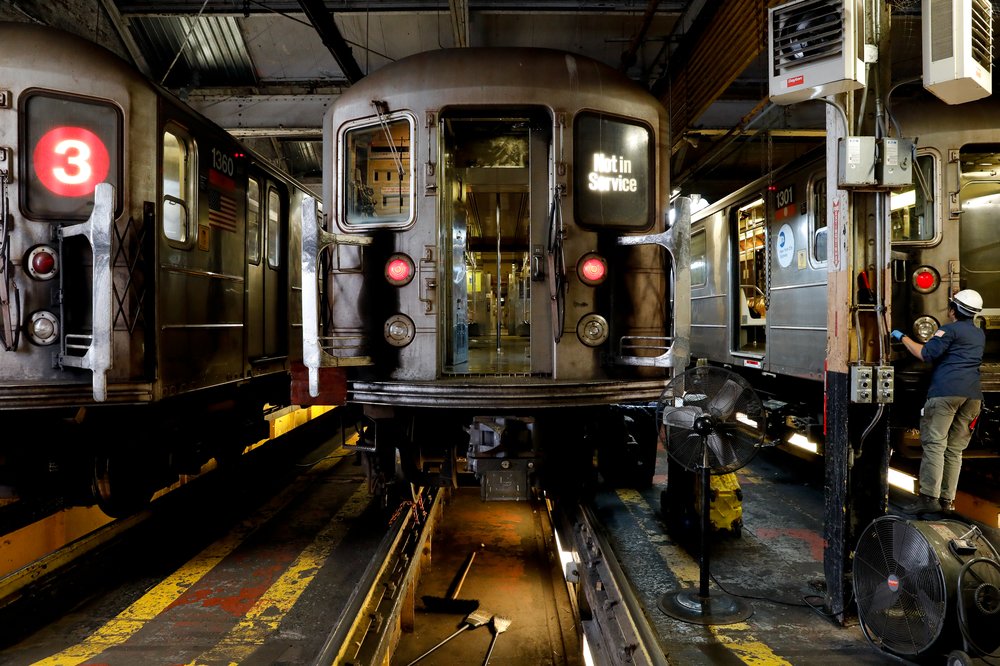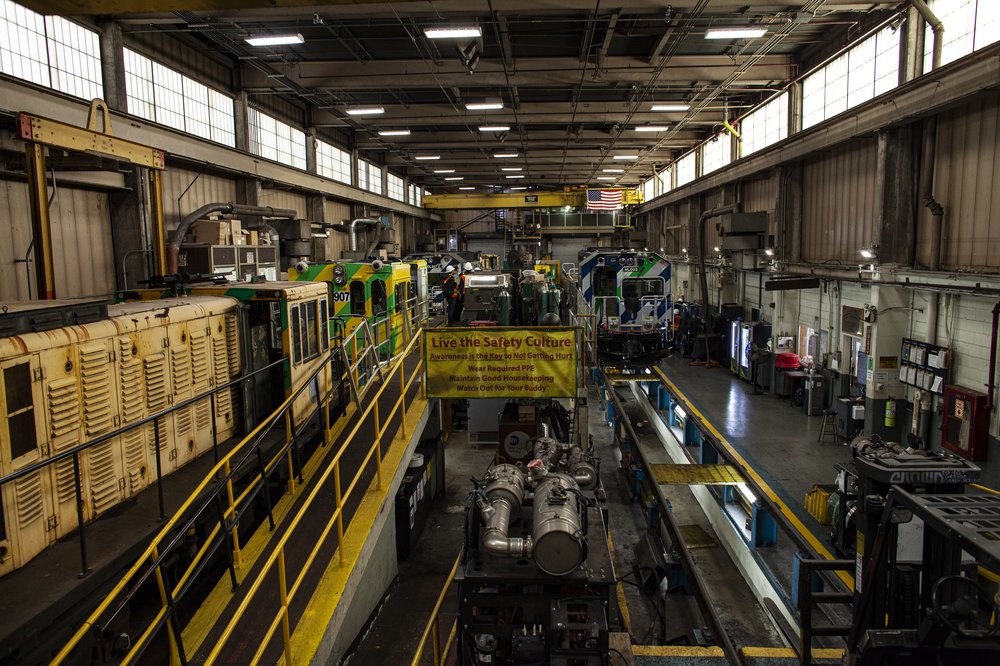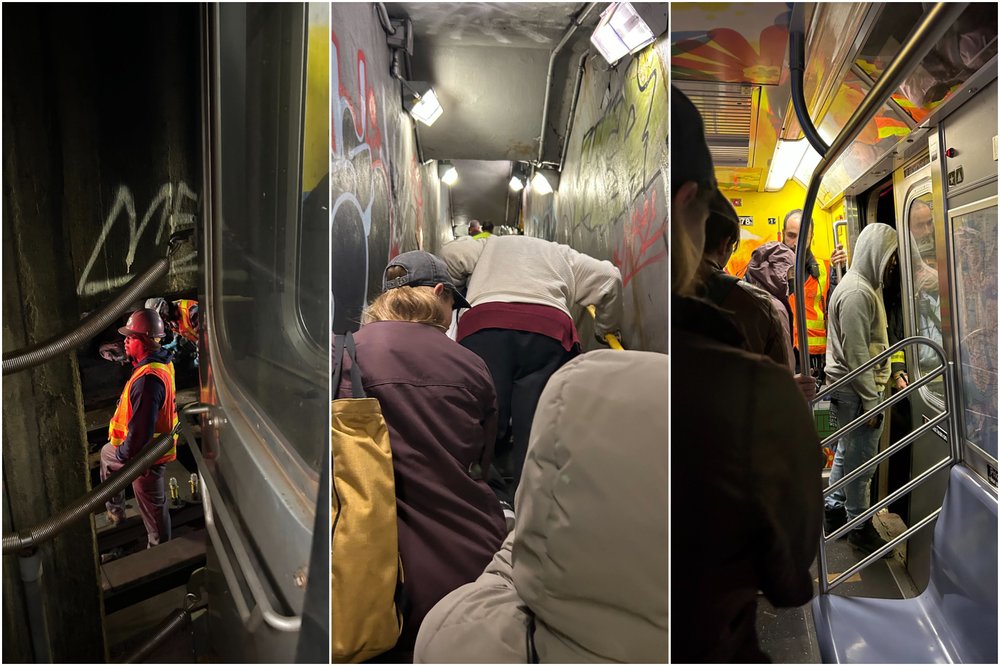A state of collapse: How the MTA put riders on the fast track to ruin
Jan. 13, 2025, 6:01 a.m.
The city’s subways aren’t just on the brink of collapse — the breakdown of the aging system has already begun.

In the peak of a rainy evening rush hour on Dec. 11, an F train in a Brooklyn subway tunnel came to a screeching halt.
Many of the 1,700 commuters on board let out a familiar groan. After around 20 minutes, they realized this delay was different.
“I’m going to try again and see if the train moves, just hold on to something, in case it jerks back,” the train’s operator said over the loudspeaker, according to video from the scene. “I don’t know if it’s going to work, but cross your fingers.”
The riders heard a few loud clicks and a high-pitched whirring sound. Then the train fell silent again.
“I tried, I’m sorry,” the conductor said, prompting jaded laughter from riders.
Both the operator and his train were literally powerless. A nearby substation room in Downtown Brooklyn that feeds electricity to the subway’s third rail had exploded with enough force to blow a door off its hinges and onto the tracks, according to internal MTA records obtained by Gothamist. Service was halted on the A, C, G and F lines for upwards of three hours, sending tens of thousands of New Yorkers onto rain-slicked streets to figure out a new way home.
The exact cause of the explosion is still under investigation, but MTA officials said the electrical room relied on 90-year-old technology. That’s not unusual. According to the transit agency, 77 out of the 224 substations that power subway trains in New York City are in similar shape and in dire need of upgrades due to outdated, unreliable technology.

Images from an MTA incident report show the aftermath of an electrical substation explosion that left F train riders stranded for hours last month.
The system breakdown that left riders stranded in subway tunnels for hours points to a sobering reality. The city’s subways aren’t just on the brink of collapse — the breakdown of the aging system has already begun. The number of train delays caused by faulty infrastructure and equipment last year shot up by 46% since 2021, MTA data shows. Major incidents — defined as problems that delay 50 or more trains, like the one on Dec. 11 — reached their highest levels last year since 2018.
During a three-month investigation, Gothamist reporters toured eight transit facilities that are off limits to the public and got a first-hand look at the MTA’s old, crumbling infrastructure. Reporters interviewed more than 100 riders on nearly every subway line across the city about the daily inconveniences they endure due to the shoddy system.
"The way the world looks at New York, it's like there's so much money here. It's like the capital of capitalism, everything's great and whatever. And the train is terrible," said J train rider Marcela Toro, 34.
Internal MTA records obtained by Gothamist and the agency’s public data reveal that service breakdowns are on pace to become more frequent in 2025 than during New York’s infamous “summer of hell” in 2017, when the subway’s reliability fell to its lowest level in decades. MTA officials blame those problems on “deferred maintenance,” or decades of cost-saving measures that kept equipment in use far past its expiration date. But those same problems persist, and experts warn the same thing is about to happen again, creating cascading issues throughout the system.
"If you don't invest in the foundation of a house, the house is going to fall down when the wind comes,” said John Samuelsen, international president of the Transport Workers Union.
The MTA has faced criticism for decades due to a lack of investment in its infrastructure. Transit officials were forced to scale back maintenance work during the financial crisis of the 1970s. And during the 1990s, under former Gov. George Pataki, a reduction of state funding for the MTA’s construction budget forced the agency to take on billions in debt that it’s still paying off.
State lawmakers are now debating whether – and how – to fund an ambitious MTA plan to repair the system. The MTA wants $65 billion to repair and upgrade the MTA’s core infrastructure over the next five years, including new train cars and electrical systems across the region. The MTA says it has funding for less than half of the plan, meaning that state lawmakers need to find at least $33 billion to make it a reality. The top two members of the Legislature vetoed the plan last month as they negotiate over its funding, which is likely to come in the form of new or dedicated taxes for the MTA.

The money for that plan doesn’t include the $15 billion that’s supposed to be financed by Manhattan’s new congestion pricing tolls, which are required to pay for mass transit upgrades that were first planned in 2019.
MTA Chair Janno Lieber has in recent months said that “subway service is the best it’s been in a million years.” But in interviews with Gothamist, he also acknowledged the system’s tenuous state, saying many of the agency’s trains are held “together with rubber bands and paper clips.”
MTA officials warn their $65 billion plan doesn’t even cover all the work needed to keep the subways from falling apart. Experts warn that the jaw-dropping cost of the plan points to another major problem for all sorts of public works in New York: Infrastructure upgrades are hampered by the city's construction costs, which are among the highest in the world. The MTA has a long history of mismanaging taxpayer dollars. For example, the agency’s East Side Access project, which opened in 2023 as the new Grand Central Madison Terminal, took more than 55 years to complete. Its final phase ran more than $8 billion over its original budget.
Lieber, who previously ran the MTA’s construction department before taking over as the agency’s chair in 2021, has argued he’s made reforms to avoid further gross mismanagement of projects. Still, the MTA’s sky-high building costs persist.
“In the U.S. we pay more for stuff, and not just like 10% more, but sometimes by a factor of two, three, four, five,” said Eric Goldwyn, who oversees NYU's Transit Cost Project. “We could do better, we could do faster, we could do cheaper.”
Keeping water out with ‘chewing gum and twine’
The subway system runs on electricity, which makes the system vulnerable to the growing number of flash floods fueled by climate change. On a dry day, 254 pump rooms pump about 14 million gallons of water out of the subways. During Hurricane Sandy in 2012, the system was inundated with more than 60 million gallons.
The equipment that expels water from the system includes technology installed in the 1920s, according to Jamie Torres-Springer, the MTA’s head of construction.

Two of those old pumps are behind a door at the 116th Street station on the 2 and 3 lines. Commuters who pass by likely have no clue they’re standing just feet away from infrastructure that looks like it should be in a museum.
The two oldest pneumatic pumps in the room are so old they can’t be automated and run on air pressure that’s calibrated by the twist of a handle.
The 98-year-old pump room is about as big as a public bathroom with two stalls. The four pumps inside — the two pneumatic ones that pre-date the Great Depression, and two newer electric ones — are responsible for removing water from the tracks throughout the area.
The subway station sits in a geological bowl, and heavy rain can easily overwhelm the pumps. When the area was a wetland, a stream ran from where the 116 Street subway station is now to the East River. That makes the subway tunnels in the area especially susceptible to flooding. Even on a dry day — like one during the recent historic drought — a 12-foot-deep sump pump was still half full with water.
“A pump room like this, the equipment is over 100 years old, so it's often in poor condition,” said Torres-Springer.
“It's being held together with chewing gum and twine in a lot of cases and it doesn't have the capacity to handle the water flow that we see because of heavier rainfall events.”
The MTA is allocating $700 million in its next capital plan to upgrade more than a dozen pump rooms with state of the art equipment. The century-old pumps like the one at 116th Street can push out 150 gallons per minute — but more modern ones can push 1,500 gallons per minute, according to MTA officials.

Karen Grigoryan, acting general superintendent for hydraulics at NYC Transit, said modern pumps send automatic alerts when a tunnel is flooding, improving the odds that service will be able to stay on track.
“We will have a high water alarm ringing at our quarters before anything severe happens on the track, or any damages occur,” he said. “And we can respond and see what else needs to be done.”
The MTA’s tools to fix the subways are busted
Any time the MTA dispatches crews to fix a section of track or replace broken equipment, they arrive on a diesel-powered work train. But many of those locomotives date back to the 1960s and frequently break down.
The MTA reports 44% of its 100 work train locomotives and 500 work train cars are “beyond their useful life.”
Those train cars, which haul tools, equipment and other materials, are essential to fixing the subway.

“Every week there are projects that we're trying to do within our system that we're not able to proceed with because we don't have enough functioning work trains,” said Torres-Springer. “So it's not that work trains are breaking down in the middle of us doing work. It's that at the beginning of the weekend, we have to say, ‘Well gee, all these closures, the disruptions of service that we've planned. We can't do them all because we don't have enough work trains.’”
Kim Jaime, a home health worker whose daily commute from Far Rockaway to the Bronx amounts to a tour of the subway’s poor infrastructure, said she’s constantly delayed by night and weekend construction.
“There's always delays. They're always fixing the track. It's always something,” said Jaime, 52, as she went to work on a recent morning. “I’m always on the train. It’s like I live on public transportation.”
Deferred repairs at the repair shop
A big reason the MTA has problems with its work trains can be found at the Westchester Locomotive Shop, one of two yards where the work trains are maintained and repaired.
The sprawling facility has two assembly lines for repair work. But the cranes that lift the trains from tracks onto stands for repairs are so old that they can no longer pick up the weight, according to crews at the facility. In order to move the cars to the assembly lines, crews instead use a set of jacks that workers said are near the end of their useful life.
During a visit to the site on a cold day in November, the facility's heaters broke down, forcing all work at the building to stop. Dane Burkett, the superintendent at the facility, said the breakdown wasn’t an uncommon occurrence.
“It can be difficult to motivate personnel to work when it’s 32 degrees or 40 degrees inside your workspace,” Burkett said. “The employees are motivated to go outside and do work, but they need a place where you have certain crew comforts.”
Work train breakdowns are mostly felt by weekend commuters, who are riding the rails when the agency does many significant repairs.
“I don’t know what’s happening with the MTA, forgetting that people work on the weekends,” said J train rider Alice Acosta as she waited for a delayed train at Brooklyn’s Myrtle-Broadway station. “Sometimes I have to go into Queens before I can go into Manhattan.”
Acosta, 20, said she’s late for work on her weekend shifts if she doesn’t plan far in advance.
If Albany lawmakers agree to a version of the MTA’s $65 billion request, weekend outages wouldn’t become a thing of the past. In fact, they’d become more frequent. But Torres-Springer noted the plan would also deliver modern work trains so crews can more efficiently get repairs done.
“When a train car breaks down, that’s what causes these massive service disruptions in our system that are so frustrating for our customers,” Torres-Springer said.
More delays ahead
While lawmakers mull over ways to pay for the MTA’s huge bill, major incidents are becoming more common.
MTA data shows that last August, an infrastructure or equipment problem caused a delay somewhere on New York City’s 665 miles of subway tracks every 3 minutes and 12 seconds. Three years before, those problems delayed a train every 5 minutes and 7 seconds. But that data doesn’t fully capture the extreme delays, like last month’s substation explosion that stranded F train riders in a Brooklyn tunnel.
“Very quickly, the messages became, we have no idea what's going on and we have no idea how long we'll be here, the third rail is down,” recalled Carla Sosenko, a Brooklynite who was trapped on one of the stalled F trains for three hours. “It just kind of degraded from there.”

Stranded F train riders were escorted out of subway tunnels in Downtown Brooklyn after a power outage.
Sosenko, 48, said she was wearing the worst outfit for a three-hour delay in a subway car without air conditioning: leather pants and a tiny purse that didn’t have enough room for her Xanax prescription, which she wished she’d had.
As the delay dragged on and riders were unsure of when help would arrive, some took to urinating between subway cars. Others left the train on their own and sought an escape from the dark subway tunnels, a dangerous move that sent officials scrambling to find the stragglers before they turned the power back on.
“ People were pretty stoic,” Sosenko recalled of riders on her train car.
Firefighters finally showed up and started escorting Sosenko and her fellow riders along a bench wall in the train tunnel. As the exhausted riders made their way up a graffiti-covered emergency stairway, one remarked they felt like they were in a scene from the cult classic “The Warriors,” set in a dystopian, lawless New York City.
Knowing full well that everyone would be recording this moment on their phones, the first responders told riders to hold the railing with their left hand while filming with their right.
- heading
- New York City’s troubled subways
- image
- image
- None
- caption
- body
This is the first in a series of stories reporting on the state of New York City’s subway system. Gothamist reporters found cascading problems that mean commuters will face increased unreliability and delays without substantial investment. Read about the subways’ vulnerable electrical substations here.
Here’s how we reported it:
- Reporters gained access to eight MTA facilities in disrepair and interviewed dozens of employees about the city’s aging mass transit infrastructure.
- We interviewed nearly 100 riders across almost every subway line in the city and heard how unreliable transit disrupts their daily lives.
- We obtained internal MTA records detailing major subway delays, and analyzed more than a decade of data to reveal how service is trending in the wrong direction.